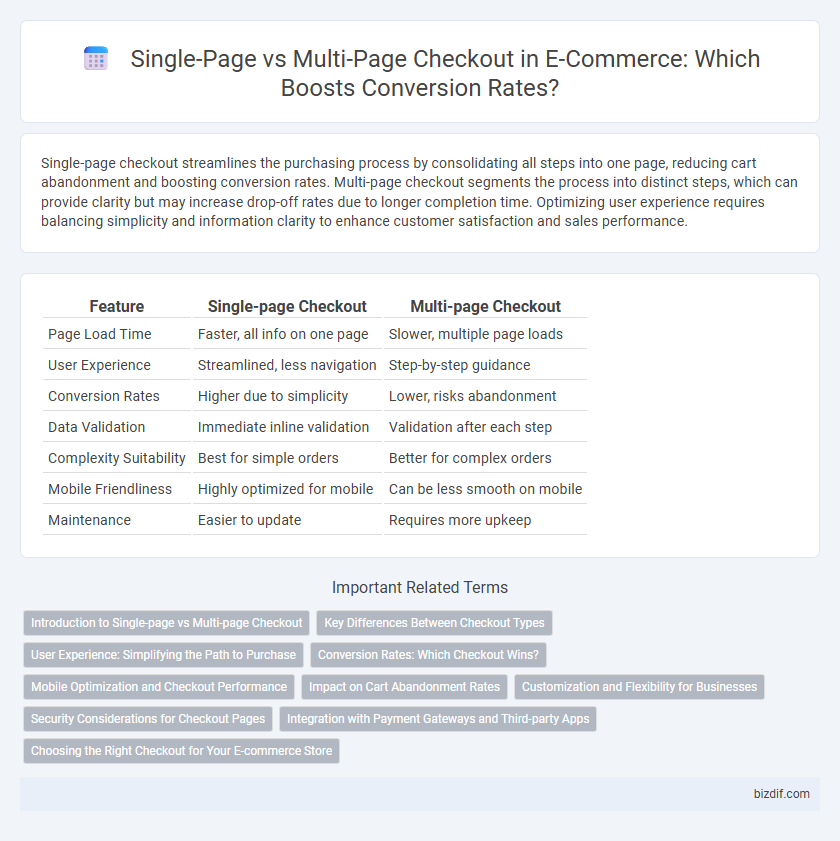Single-page checkout streamlines the purchasing process by consolidating all steps into one page, reducing cart abandonment and boosting conversion rates. Multi-page checkout segments the process into distinct steps, which can provide clarity but may increase drop-off rates due to longer completion time. Optimizing user experience requires balancing simplicity and information clarity to enhance customer satisfaction and sales performance.
Table of Comparison
| Feature | Single-page Checkout | Multi-page Checkout |
|---|---|---|
| Page Load Time | Faster, all info on one page | Slower, multiple page loads |
| User Experience | Streamlined, less navigation | Step-by-step guidance |
| Conversion Rates | Higher due to simplicity | Lower, risks abandonment |
| Data Validation | Immediate inline validation | Validation after each step |
| Complexity Suitability | Best for simple orders | Better for complex orders |
| Mobile Friendliness | Highly optimized for mobile | Can be less smooth on mobile |
| Maintenance | Easier to update | Requires more upkeep |
Introduction to Single-page vs Multi-page Checkout
Single-page checkout condenses all purchase steps into a single, streamlined form, reducing friction and cart abandonment for faster transactions. Multi-page checkout divides the process into multiple stages, allowing detailed data input but potentially increasing dropout rates due to longer completion time. E-commerce platforms evaluate user behavior and conversion metrics to determine the optimal checkout flow that maximizes sales and minimizes customer frustration.
Key Differences Between Checkout Types
Single-page checkout consolidates all purchase steps into one streamlined screen, reducing cart abandonment by minimizing navigation and form fills. Multi-page checkout breaks the process into multiple steps, which can enhance clarity but often results in longer completion times and higher drop-off rates. Key differences include user experience speed, conversion rates, and potential for collecting customer data at various stages.
User Experience: Simplifying the Path to Purchase
Single-page checkout streamlines the purchase process by consolidating all necessary fields on one page, reducing friction and minimizing cart abandonment rates. Multi-page checkout, while offering a step-by-step progression, can increase user drop-off due to longer load times and perceived complexity. E-commerce platforms focused on optimal user experience prioritize single-page checkouts to enhance speed, security clarity, and user confidence during transactions.
Conversion Rates: Which Checkout Wins?
Single-page checkout typically yields higher conversion rates by minimizing friction and reducing the time required to complete a purchase, which decreases cart abandonment. Multi-page checkout often leads to drop-offs at each stage due to the increased effort and perceived complexity, negatively impacting overall conversion. Optimizing a streamlined, intuitive single-page checkout with clear progress indicators enhances user experience and boosts sales performance.
Mobile Optimization and Checkout Performance
Single-page checkout enhances mobile optimization by reducing page loads and simplifying navigation, leading to faster load times and decreased cart abandonment rates. Multi-page checkout, while potentially providing more detailed information per step, often results in slower performance and increased friction on mobile devices. Prioritizing a single-page checkout design significantly improves overall mobile user experience and boosts conversion rates in e-commerce.
Impact on Cart Abandonment Rates
Single-page checkout streamlines the purchasing process by reducing the number of actions required, significantly lowering cart abandonment rates compared to multi-page checkouts. Multi-page checkout often introduces friction through multiple steps, leading to frustration and increased dropout rates, with studies showing abandonment rates as high as 70% on complex multi-step processes. Optimizing checkout flow by minimizing form fields and consolidating steps directly improves conversion rates and enhances overall user experience in e-commerce.
Customization and Flexibility for Businesses
Single-page checkout streamlines customization by allowing businesses to tailor the entire purchase experience on a single interface, improving customer convenience and reducing cart abandonment. Multi-page checkout offers flexibility by enabling segmented data collection and targeted upselling opportunities across different stages, ideal for complex transactions. Businesses seeking rapid deployment and simple customization often prefer single-page options, while those requiring detailed user input and adaptive workflows benefit from multi-page checkouts.
Security Considerations for Checkout Pages
Single-page checkout simplifies user experience by consolidating all payment and shipping fields into one page, reducing navigation risks and potentially lowering exposure to session hijacking due to fewer page transitions. Multi-page checkout allows for discrete security measures on each step, such as individual SSL certifications and targeted fraud detection, enhancing protection of sensitive data throughout the transaction process. Implementing strong HTTPS protocols, tokenization, and PCI DSS compliance is crucial for both checkout types to safeguard user financial information and maintain trust in e-commerce platforms.
Integration with Payment Gateways and Third-party Apps
Single-page checkout streamlines Payment Gateway and third-party app integration by consolidating transaction data into a single API call, reducing latency and minimizing errors during payment processing. Multi-page checkouts often require complex synchronization across pages, increasing the risk of session timeouts and data mismatches in plugin communication. Optimizing checkout flow with real-time Payment Gateway validation and seamless third-party app interoperability enhances conversion rates and reduces cart abandonment.
Choosing the Right Checkout for Your E-commerce Store
Single-page checkout streamlines the buying process by consolidating all required fields into one page, reducing cart abandonment rates and enhancing user experience through faster transactions. Multi-page checkout, on the other hand, breaks the process into multiple steps, which can simplify complex purchases and collect more detailed customer information but may increase drop-off rates. Choosing the right checkout depends on your e-commerce store's product complexity, customer behavior analytics, and the balance between speed and data collection priorities.
Single-page Checkout vs Multi-page Checkout Infographic

 bizdif.com
bizdif.com